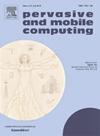On-device indoor place prediction using WiFi-RTT and inertial sensors
IF 3.5
3区 计算机科学
Q2 COMPUTER SCIENCE, INFORMATION SYSTEMS
引用次数: 0
Abstract
High-accuracy and low-latency indoor place prediction for mobile users can enable a wide range of applications for domains such as assisted living and smart homes. In this paper, we propose GoPlaces, a practical indoor place prediction system that works on mobile devices without requiring any new infrastructure. GoPlaces does not rely on servers or specialized localization infrastructure, except for a single cheap off-the-shelf WiFi access point that supports ranging with Round Trip Time (RTT) protocol. GoPlaces enables personalized place naming and prediction, and it protects users’ location privacy. It fuses inertial sensor data with distances estimated using the WiFi-RTT protocol to predict the indoor places a user will visit. GoPlaces employs an attention-based BiLSTM model to detect user’s current trajectory, which is then used together with historical information stored in a prediction tree to infer user’s future places. We implemented GoPlaces in Android and evaluated it in several indoor spaces. The experimental results demonstrate prediction accuracy as high as 86%. Furthermore, they show GoPlaces is feasible in real life because it has low latency and low resource consumption on the phones.
使用WiFi-RTT和惯性传感器的设备室内位置预测
移动用户的高精度和低延迟室内位置预测可以为辅助生活和智能家居等领域提供广泛的应用。在本文中,我们提出了GoPlaces,这是一个实用的室内位置预测系统,可以在移动设备上工作,而不需要任何新的基础设施。GoPlaces不依赖于服务器或专门的定位基础设施,除了一个廉价的现成WiFi接入点,它支持往返时间(RTT)协议。GoPlaces支持个性化的地点命名和预测,并保护用户的位置隐私。它将惯性传感器数据与使用WiFi-RTT协议估计的距离融合在一起,以预测用户将访问的室内位置。GoPlaces采用基于注意力的BiLSTM模型来检测用户当前的轨迹,然后将其与存储在预测树中的历史信息一起使用,以推断用户未来的位置。我们在Android上实现了GoPlaces,并在几个室内空间中进行了评估。实验结果表明,预测准确率高达86%。此外,他们还表明,GoPlaces在现实生活中是可行的,因为它在手机上具有低延迟和低资源消耗。
本文章由计算机程序翻译,如有差异,请以英文原文为准。
求助全文
约1分钟内获得全文
求助全文
来源期刊

Pervasive and Mobile Computing
COMPUTER SCIENCE, INFORMATION SYSTEMS-TELECOMMUNICATIONS
CiteScore
7.70
自引率
2.30%
发文量
80
审稿时长
68 days
期刊介绍:
As envisioned by Mark Weiser as early as 1991, pervasive computing systems and services have truly become integral parts of our daily lives. Tremendous developments in a multitude of technologies ranging from personalized and embedded smart devices (e.g., smartphones, sensors, wearables, IoTs, etc.) to ubiquitous connectivity, via a variety of wireless mobile communications and cognitive networking infrastructures, to advanced computing techniques (including edge, fog and cloud) and user-friendly middleware services and platforms have significantly contributed to the unprecedented advances in pervasive and mobile computing. Cutting-edge applications and paradigms have evolved, such as cyber-physical systems and smart environments (e.g., smart city, smart energy, smart transportation, smart healthcare, etc.) that also involve human in the loop through social interactions and participatory and/or mobile crowd sensing, for example. The goal of pervasive computing systems is to improve human experience and quality of life, without explicit awareness of the underlying communications and computing technologies.
The Pervasive and Mobile Computing Journal (PMC) is a high-impact, peer-reviewed technical journal that publishes high-quality scientific articles spanning theory and practice, and covering all aspects of pervasive and mobile computing and systems.
 求助内容:
求助内容: 应助结果提醒方式:
应助结果提醒方式:


